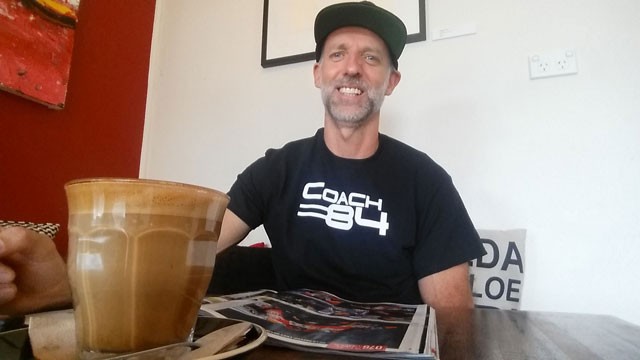BMX and Weight Loss
Can riding a small bike lead to large weight loss?
What’s going on with Ultra? Have we gone all celebrity and about to bring you the latest diet endorsed by Anthony Dean or Sam Willoughby to shred those abs and pack on lean muscle mass? Well, no. But these two talented Australian BMX athletes are prime examples that riding and racing a BMX bike can not only boost your fitness, it can also keep you lean with low levels of body fat.

Granted, these two boys are in their early 20s and full time athletes at the peak of their careers, but they illustrate clearly that you don’t need to don the lycra and head out onto the road, putting in miles and miles on a roadie in order to be a lean mean racing machine. At any local caffeine refuelling station on a Saturday morning you can see plenty of examples of lycra clad middle aged men and women who have been out on their 3 hour bike ride, yet aren’t exactly exhibiting athletic qualities. And yet traditionally, the type of exercise prescribed for fat loss is low intensity in nature, conducted over an hour or so like cycling or jogging. Or simply going out for a walk around the block. But I’m sure some of you readers have tried this and know that this is often a futile pursuit. Most give up inside a month, frustrated that there’s been no significant weight loss.
So, weight loss and riding a BMX bike. Can it be done? Can you combine what you already love to do and drop body weight? Yes, it’s definitely possible, and there are plenty of older racers showing you that you can. Skinny old blokes who are still fast and determined, and herein lies a clue to maintaining a lean body. But before we look at how BMX can contribute to a healthy lifestyle, a little background on what BMX racing/training actually does for your body, and where it fits in in the world of exercise types.
HIIE –High Intensity Intermittent Training
There has been plenty of focus and research in the past 15-20 years around High Intensity Intermittent Exercise (HIIE, or HIIT – High Intensity Interval Training) and its role in maintaining a healthy weight range in an adult. As well as controlling the onset of obesity and obesity related diseases such as Type II diabetes, heart disease and cancer.
Guess what? Racing and training for BMX racing is exactly that; HIIE. Short bursts of 100% effort followed by a rest (laying on the ground usually for the author). Anecdotally, it’s been recognised for a number of years that this style of exercise regime can help individuals stay lean and fit. But it took the wider community and fitness industry many years to embrace this. I know what some of you are thinking right now… “I ride and race BMX but I don’t lose weight!” I hear your frustration, so let me elaborate a little. Please be patient up the back, you BMX racers have such attention spans…..
What I’m about to tell you may be slightly discomforting, so sit down and take a couple of deep breaths… YOU HAVE TO TRAIN HARD. There, nice and quick, like taking off a bandaid. I’m not suggesting for a minute that you don’t train hard, but it has to be a systematic approach over a number of weeks to be effective and this is where most BMX racers falter. Their training is too ad hoc. Rock up and do some gates, ride another day and do some jumps. Race a clubbie. Sound familiar? Don’t get me wrong, and DON’T stop because you’re still doing what 90% of the population isn’t, regularly exercising. Going outside and spending time with your kids riding. Don’t forget about your mental health, absolutely vital for a happy life.
HIIE training can be composed of a few combinations of work (exercise) and rest (laying on the ground) ratios. Lots of the research focuses on the Wingate test, but ratios can vary from 10s of effort/20s of rest, to 30s/30s, to 30s/4 mins of rest (a more athletic training ratio). All repeated 4 to 6 times for a total of 3 to 4 minutes of exercise at full noise. The thing is though; this type of training is hard! It’s not recommended to deconditioned adults, but you’re already racing BMX and thus already pushing your body to its limits (bloody well done!).
Okay, so are you still with me? The hardest thing for people to get their head around is that the time spent exercising is so short compared to what’s been drummed into us over time. So how do you drop weight? Is it possible without wearing lycra?
Weight loss – why do so many fail?
I’ve worked in the fitness industry for over 25 years, working directly administering training programs (a long time ago), to managing large gyms with up to 20 personal trainers and all sorts of activities promoted as weight loss exercises. Thousands of people have walked through the doors of these facilities with the same goal as you, to lose weight. The failure percentage probably isn’t any different to those who take up an exercise program from home, or who try the latest diet, but I have seen firsthand people achieve great success, and let me tell you the magic ingredient:
THEIR SHEER DETERMINATION TO SUCCEED!
Are you completely shocked? I didn’t think so. I’ve seen all the programs, all the celebrity endorsed machines and read accounts of hundreds of people who say that a certain ingredient worked miracles and achieved a 10kg weight reduction in 5 weeks. What is common amongst those people I’ve seen lose up to 20kg of more over a 6 month period is that they have reduced the number of calories that they take in every day. This again, shouldn’t come as a surprise to you. Move more, eat less. Simple huh?
Why then, is it so goddamn hard to reduce your weight? It’s because to use fat as a fuel source to produce movement (muscle contraction) a lot of complex chemical processes need to occur in order to move the fat from your stomach to the muscle fibre in your leg. The fat molecule has to move from the fatty tissue sitting just under the skin around your stomach, into the blood stream, transported to your leg muscle. From there is has to undergo another chemical process in order to be used as fuel for your muscle fibre to go “bang” and contract.
Before your body calls up the troops of fat molecules to be used, it has lots of stored energy in the form of glycogen (sugar if you like) stored in the muscles, in the blood stream and in the liver. Enough for about 45 minutes or so of low intensity exercise. It’s not until you deplete this fuel source does the body goes looking for an alternative. I’ve simplified this a fair bit, but that’s how your body chemistry works in relation to fuel sources. Let me put it another way, it’s like have a car with a petrol engine, but a diesel tank. Between the tank and the engine, the diesel would need to undergo more refining in order to be used in the engine for power. Of course, the body can also draw on amino acids as fuel, but I’m not going down that particular pathway today.
Let’s tie this together – BMX training (HIIE) and fat loss
I really haven’t given you an answer yet, and again I’m not going to bore you with the findings of research articles I’ve recently read in order to write this article, but it looks as though HIIE supercharges the usage of fat as a fuel source. Mostly post exercise where your body is recovering from the hammering you gave it. HIIE should only be conducted 3 times a week because of the toll it takes on the body and indeed, when I write a 12 week training program for older BMX racers, it’s usually only two sessions max a week as there are many other considerations to make a racer faster. You know, gate starts, sprints and riding smooth.
A systematic approach to HIIE is required over a period of 6 to 8 weeks in order to see appreciable results in fat reduction. With BMX, I advocate a 30 second effort (usually not a full lap as most of us aren’t pros running sub 30 second lap times) on a low tech track for a 4 minute recovery. 4 to 6 repeats depending on your mental strength. The usual warm up procedures apply and if you’re over 40 and overweight, I recommend a full stress test as a normal precaution before you take on any sort of strenuous exercise program. Go see your doc. Though my personal GP reckons I stress test my body 3 times a week and reluctantly referred me to the cardiologist. He’s a funny bloke and that’s why he’s a great doc. Straight up.
But, you won’t lose any weight by training like this without a major modification to your diet, and this is the hard part. And the most personal part of the program. I cannot sit here and type out a diet for you to follow because I’m not a dietician, but I can categorically hand on my heart say, that all the supplementation in the world won’t help you without making changes in the way you think about, and consume food. There’s no over the counter magic bullet. There’s no magical ingredient extracted from a root of a tropical plant found only on the island where King Kong came from. Both of these are myths.

Fat mobilisers, protein shakes and all of the other snake oils I see the Instagram famous trainers and nutritionists spruiking are a waste of your hard earned dollars. I’d personally rather spend my cash on a nicely prepared meal and tasty beer than a chemically enhanced concoction formulated in some laboratory.
What will happen if you adopt this type of training into your regime is that your fitness will go through the roof! Your racing performance will improve, as will your results. Your legs won’t fail down the third rhythm straight and therefore you won’t die from exploding on the last step-up! All bonuses.
As for that 10-20kg you want to knock off, this will take a very determined effort, but it’s not impossible. Contact me if you’d like to give it a shake (no pun intended).
About Bruce Morris #84
- Brisbane Australia
- BMX Racer – 35+ years
- Fitness Professional – 25+ years of operating gyms and training people
- Coach 84 BMX Training – Coaching the 30+ racers. Spanning performance, fitness and healthiness
Posted in: News




